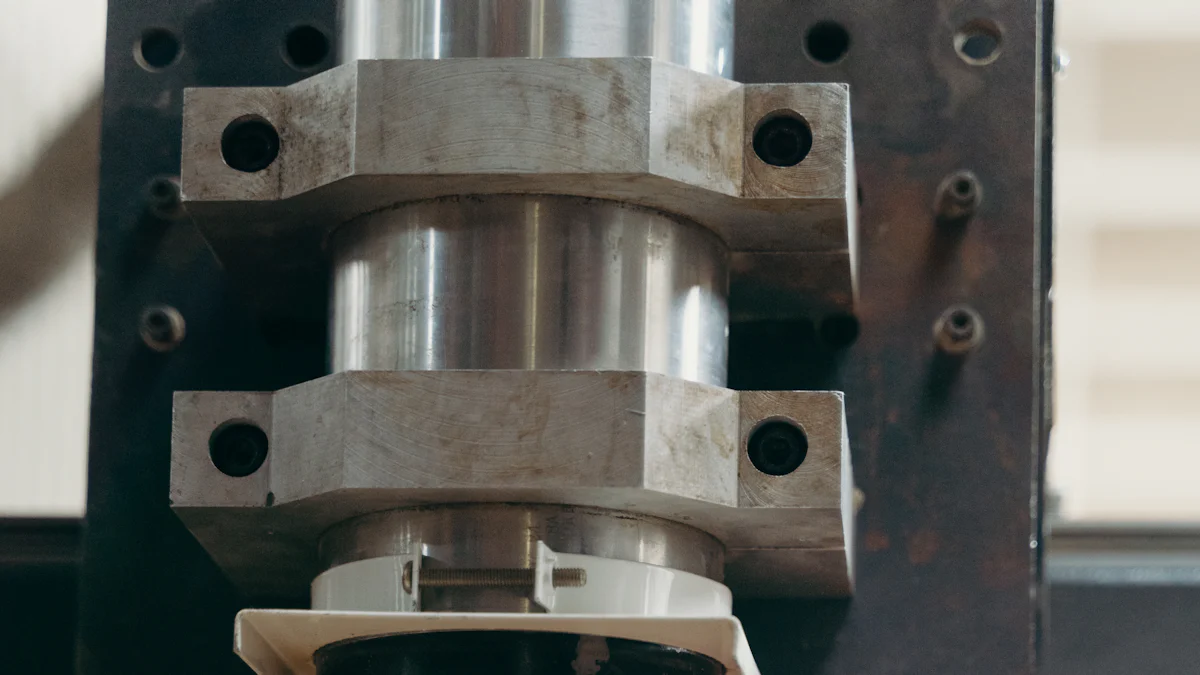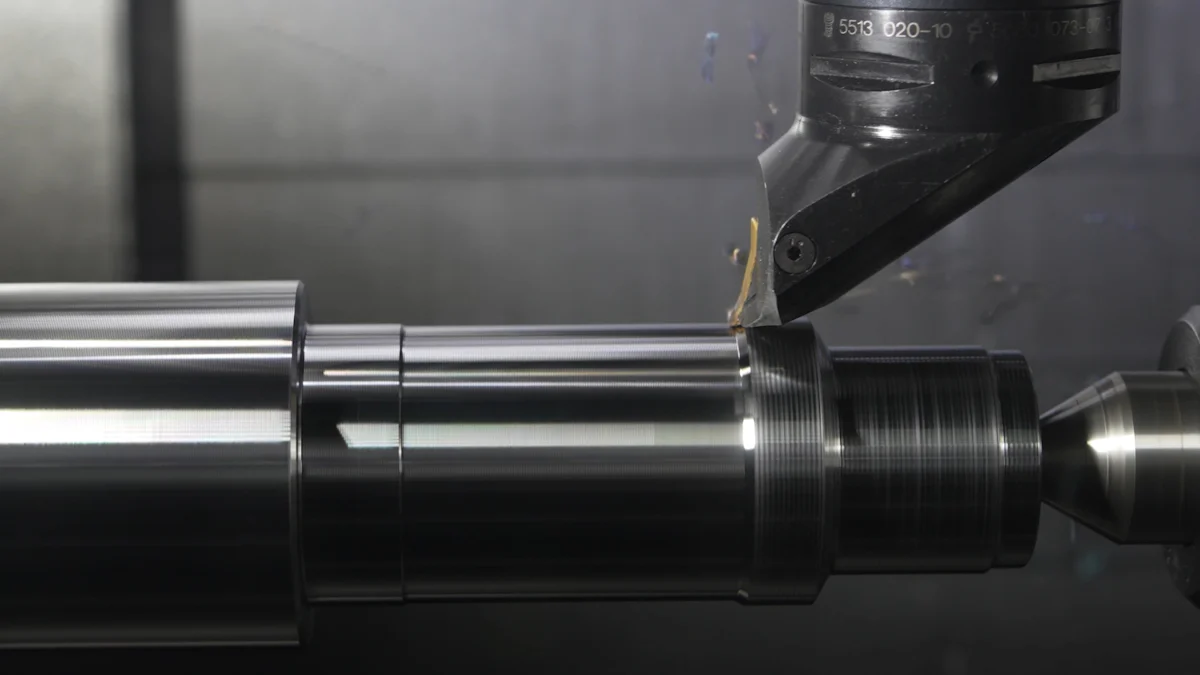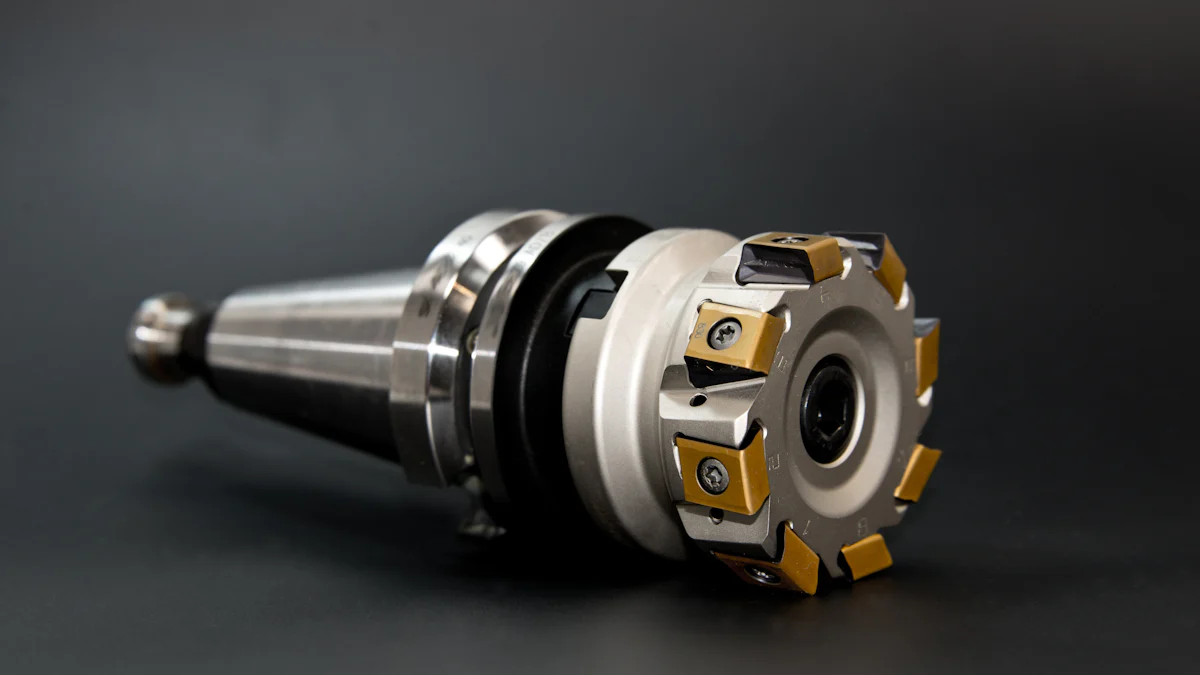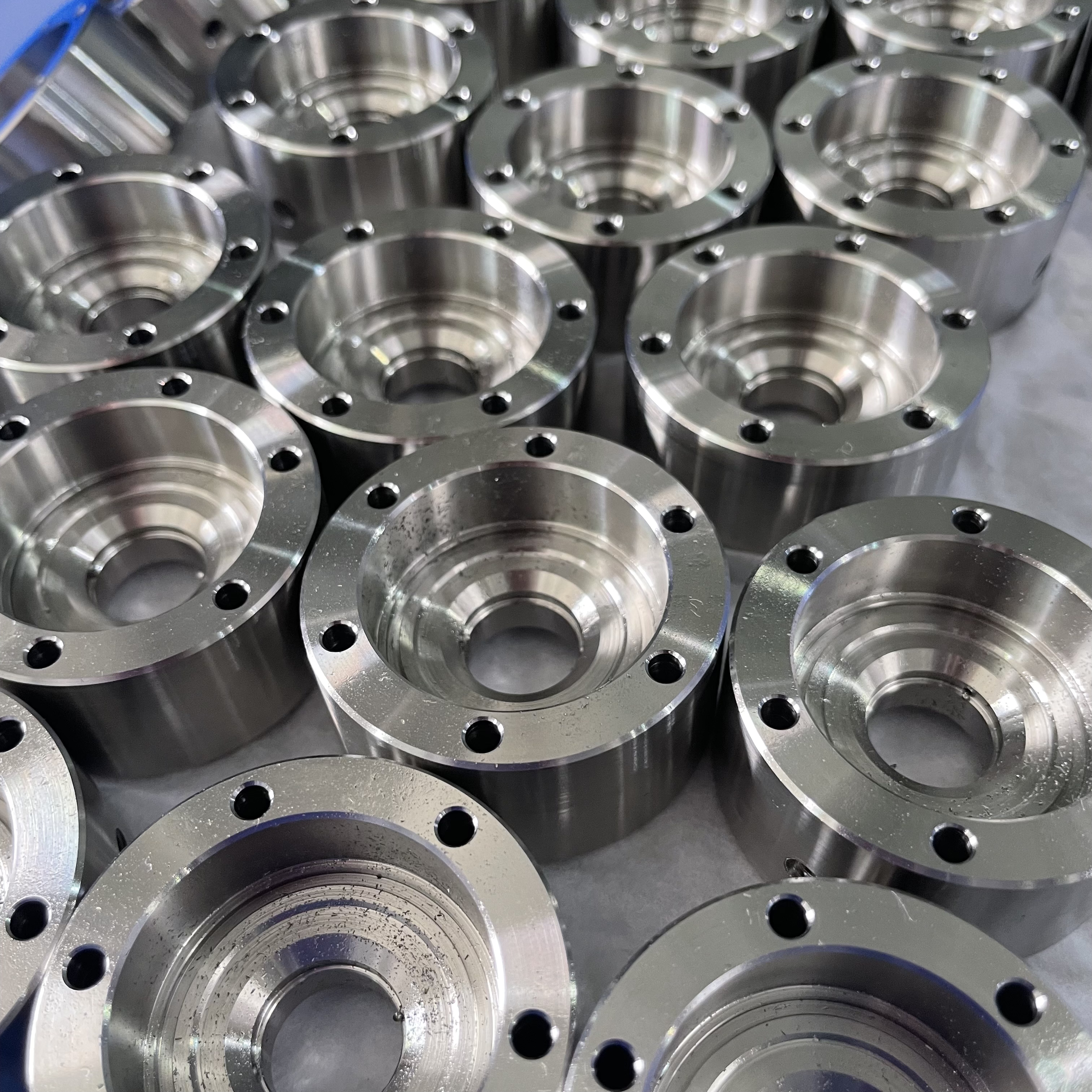Comparing Aluminum vs. Steel in CNC Applications

Choosing the right material for CNC machining can significantly impact your project's success. Aluminum and steel offer distinct advantages, making them suitable for different applications. For example, aluminum's lightweight nature makes it ideal for weight-sensitive designs, while steel provides superior strength for heavy-duty parts. Material properties like ductility, manufacturability, and cost also play a crucial role. Additionally, factors such as strength-to-weight ratio and thermal conductivity affect machining performance and product quality. By understanding these differences, you can ensure your CNC machined components meet industry standards and perform optimally in their intended use.
Quick Comparison:
Factor
Aluminum
Steel
Weight
Lightweight, ideal for weight-sensitive apps
Heavier, advantageous for stability and strength
Strength
Good strength-to-weight ratio
Superior absolute strength, especially in high-carbon variants
Key Takeaways
Aluminum is light and great for uses needing less weight, like planes and cars.
Steel is very strong and lasts longer, so it’s best for tough tools and heavy parts.
Think about rust: aluminum doesn’t rust easily, but steel needs coatings to stop rust.
Cutting is different: aluminum is faster to cut and wears tools less, but steel needs stronger tools and slower cutting.
Look at costs: aluminum saves time when cutting, but steel costs less at first.
Key Property Comparison: Aluminum vs Mild Steel

Strength Comparison
Tensile Strength and Durability
When comparing the strength of aluminum vs mild steel, you’ll notice significant differences in their mechanical properties. Mild steel offers higher tensile strength, with up to 25% more yield strength and 50% greater ultimate tensile strength than 6061-T6 aluminum alloy. This makes steel a better choice for structural components requiring high durability. Aluminum, while lighter and weaker, can achieve impressive strength-to-weight ratios when alloyed with other elements. For projects where weight reduction is critical, aluminum provides a balance of strength and lightweight benefits.
Steel typically has higher tensile and yield strengths.
Aluminum alloys excel in applications needing a high strength-to-weight ratio.
For maximum tensile strength, steel remains the top choice.
Impact Resistance and Wear
Steel’s durability extends to its ability to resist impact and wear. It withstands heavy loads and harsh conditions better than aluminum. However, aluminum’s natural oxide layer provides some protection against wear, making it suitable for less demanding environments. For CNC machining projects requiring high impact resistance, steel is the preferred material.
Weight Comparison
Lightweight Benefits of Aluminum
Aluminum’s density is about one-third that of steel. This makes it a standout choice for weight-sensitive applications like aerospace and automotive components. Its lightweight nature also enhances CNC machining efficiency by enabling faster machining speeds and reducing tooling wear.
Heavier but Stiffer Properties of Steel
Steel’s heavier weight contributes to its stiffness and stability. While this can slow machining processes, it ensures the material holds up under extreme stress. For projects prioritizing rigidity and strength, steel’s weight becomes an advantage.
Cost Considerations
Material Costs
Aluminum often costs more per pound than mild steel. However, its superior machinability can reduce production time and tooling wear, potentially lowering overall costs. Steel, being abundant and easier to produce, is generally cheaper upfront, making it ideal for large-scale projects.
Long-Term Cost Efficiency
Aluminum’s corrosion resistance and lightweight properties can lead to long-term savings, especially in industries like automotive, where fuel efficiency matters. Steel, while cheaper initially, may incur higher maintenance costs in certain applications. Evaluating both initial and long-term expenses helps you choose the most cost-effective material for your CNC machining needs.
Machinability in CNC Machining
Ease of Machining Aluminum
Aluminum stands out for its exceptional machinability in CNC machining. Its lower density and softer nature allow for faster cutting speeds, reducing machining time significantly. You’ll notice that aluminum causes less wear on cutting tools, which extends tool life and lowers maintenance costs. These properties make aluminum an excellent choice for projects requiring high precision and efficiency.
Additionally, aluminum’s strength-to-weight ratio enhances its performance in CNC applications. Its lightweight nature not only improves machining speeds but also reduces the strain on CNC equipment. This combination of benefits makes aluminum a preferred material for industries like aerospace and automotive, where precision and weight reduction are critical.
Challenges in Machining Steel
Steel, while offering superior strength, presents several challenges during CNC machining. Its hardness and abrasiveness demand robust cutting tools, which can wear down quickly. This increases the need for frequent tool replacements, adding to production costs. Slower machining rates are often necessary to handle steel’s toughness, which can extend production times.
Thermal distortion is another challenge you may encounter when machining steel. The heat generated during the process can affect the material’s dimensions and properties, requiring careful monitoring. Post-machining treatments, such as powder coating or electroplating, are often needed to enhance steel’s surface finish and corrosion resistance. These additional steps can complicate the manufacturing process and increase costs.
Corrosion Resistance
Aluminum’s Oxide Layer Protection
Aluminum naturally resists corrosion due to its protective oxide layer. This thin, durable layer shields the material from rust and oxidation, making it suitable for outdoor and marine environments. You’ll find that aluminum’s corrosion resistance reduces the need for additional coatings or treatments, saving time and cost in CNC machining projects. Its ability to withstand harsh conditions makes it a reliable choice for applications where exposure to moisture or chemicals is a concern.
Steel’s Need for Coatings
Steel, particularly carbon steel, is more prone to corrosion when exposed to moisture and oxygen. To combat this, various coatings are applied to enhance its durability. Powder coating, for example, creates a protective barrier against corrosive agents, while electroplating adds a metal layer to improve resistance to rust and wear. These treatments, though effective, require additional steps in the manufacturing process. If your project demands high corrosion resistance, stainless steel or coated steel may be better options.
CNC-Specific Factors for Aluminum vs Steel
Thermal Conductivity
Aluminum’s Heat Dissipation
Aluminum is an excellent thermal conductor, making it ideal for applications where heat dissipation is critical. Its ability to transfer heat efficiently prevents overheating in components like heat sinks and electronic housings. This property enhances the performance of custom CNC machining processes, especially when producing parts that require precise thermal management.
Aluminum heats up quickly during machining, so efficient cooling systems are essential.
Proper coolant flow helps manage the heat generated during cutting.
CNC machining also allows you to create complex geometries in aluminum, such as heat sinks with optimized airflow and increased surface area. These designs maximize heat dissipation, ensuring the material performs well under demanding conditions.
Steel’s Thermal Properties in Stressful Conditions
Steel has lower thermal conductivity compared to aluminum. This slower heat transfer can be advantageous in applications requiring stable temperature conditions. For example, steel components in high-stress environments benefit from this property, as it helps maintain consistent performance without rapid temperature fluctuations. However, you must carefully monitor machining processes to avoid overheating, which can affect the material's properties and tool life.
Material Availability
Common Aluminum Alloys for CNC Machining
Several aluminum alloys are widely used in CNC machining due to their versatility and machinability:
6061-T6: Lightweight and corrosion-resistant, suitable for structural applications.
7075-T6: High strength-to-weight ratio, ideal for aerospace and military uses.
6082-T6: Stronger than 6061, often used in construction.
5083-T6: Excellent corrosion resistance, perfect for marine environments.
These aluminum alloys offer a range of options for projects requiring lightweight materials with specific mechanical properties.
Common Steel Grades for CNC Machining
Steel grades vary in availability and machinability, which can impact project timelines. Common grades include mild steel for general applications and stainless steel for enhanced corrosion resistance. While steel is abundant, procuring specific grades may take longer, affecting production schedules. Choosing easily machinable grades can reduce costs and improve efficiency in custom CNC machining projects.
Surface Finish and Precision
Achieving Smooth Finishes with Aluminum
Aluminum’s softer nature makes it easier to achieve smooth finishes during CNC machining. A high-quality surface enhances the appearance, corrosion resistance, and durability of the final product. Factors like cutting speed, tool type, and feed rate play a crucial role in optimizing the finish. Aluminum’s physical properties allow for glossy, visually appealing surfaces, which are often preferred in consumer products and aerospace components.
Steel’s Challenges in Precision and Finish
Achieving precision and smooth finishes with steel can be challenging. Its hardness and poor heat conductivity often lead to rapid heating, which may damage tools and affect the material. Incorrect tool paths or feed rates can result in suboptimal machining, impacting the surface quality. Additionally, achieving a polished finish on steel requires advanced equipment and technical expertise, increasing production costs. Despite these challenges, steel remains a reliable choice for heavy-duty applications where strength and durability are paramount.
Best Applications for Aluminum and Steel in CNC Machining

Best Applications for Aluminum
Aerospace and Automotive Components
Aluminum plays a vital role in aerospace and automotive industries due to its lightweight and high strength-to-weight ratio. You’ll find it used in structural applications like aircraft frames, landing gear, and body panels. Common alloys such as 6061, 7075, and 2024 are ideal for these purposes. For example:
6061 is widely used for aircraft parts, cylinder heads, and pipes.
7075 is perfect for gears, shafts, and missile components.
2024 is suitable for structural parts in both commercial and military aircraft.
In automotive applications, aluminum excels in producing engine blocks, chassis frameworks, and suspension components. Its durability and heat resistance make it a preferred material for high-performance vehicles.
Tip: Aluminum’s corrosion resistance ensures long-lasting performance in environments exposed to moisture or chemicals.
Lightweight Consumer Products
Aluminum is a go-to material for lightweight consumer products. Its high strength-to-weight ratio makes it ideal for items like laptops, smartphones, and portable tools. You’ll appreciate its natural corrosion resistance, which enhances durability in harsh conditions. Additionally, aluminum’s machinability reduces production time and costs, while its ability to dissipate heat efficiently makes it perfect for heat sinks and cooling components. The material also supports a variety of surface finishes, allowing for both aesthetic and functional enhancements.
Best Applications for Steel
Heavy-Duty Industrial Parts
Steel’s superior strength and durability make it indispensable for heavy-duty industrial components. You’ll often see it used in gears, structural supports, and engine components. Industries like construction, energy, and manufacturing rely on steel for its ability to withstand extreme stress and wear. For example, wind turbines and drilling equipment benefit from steel’s resilience, while automotive gearboxes and engine mountings require its toughness.
High-Strength Tools and Machinery
Steel is essential for high-strength tools and machinery. Tool steels like D2, A2, and O1 offer excellent wear resistance and durability, making them ideal for cutting tools and molds. High-speed steels such as M2 and T1 maintain hardness at high temperatures, ensuring reliable performance in drill bits and end mills. These properties make steel a top choice for applications requiring precision and longevity.
Hybrid Applications
Combining Aluminum and Steel in Assemblies
Combining aluminum and steel in assemblies allows you to leverage the strengths of both materials. Aluminum’s lightweight properties complement steel’s rigidity, creating balanced designs. For instance, automotive manufacturers often use aluminum for body panels and steel for structural reinforcements. This hybrid approach optimizes performance while reducing weight.
Examples of Mixed-Material CNC Projects
Mixed-material CNC projects showcase the versatility of combining aluminum and steel. Examples include aerospace components like fuselage sections, where aluminum reduces weight and steel provides structural integrity. In industrial machinery, aluminum housings paired with steel gears enhance efficiency and durability. These projects highlight the benefits of using both materials strategically.
Summary Table: Aluminum vs Steel in CNC Machining
Key Property Comparison
Strength, Weight, Cost, Machinability, Corrosion Resistance
When comparing aluminum and steel, their properties reveal distinct advantages for different applications. The table below summarizes these key differences:
Property | Aluminum | Steel |
|---|---|---|
Density | ~2.7 g/cm³ | 7.75 to 8.05 g/cm³ |
Yield Tensile Strength | ~240 MPa (6061-T6) | 250 to 600 MPa (varies by grade) |
Corrosion Resistance | High (natural oxide layer) | Lower (prone to rust, except stainless steel) |
Thermal Conductivity | ~235 W/m·K | ~50-60 W/m·K |
Ductility | High | Lower (less ductile in high-strength grades) |
Aluminum’s lightweight nature and corrosion resistance make it ideal for weight-sensitive and outdoor applications. Steel, with its superior strength and durability, excels in heavy-duty environments.
CNC-Specific Factors
Thermal Conductivity, Availability, Surface Finish
Aluminum and steel differ significantly in CNC machining-specific factors:
Thermal Conductivity:
Aluminum dissipates heat efficiently, making it suitable for heat exchangers, engine components, and electronic housings.
Steel’s slower heat transfer benefits high-temperature applications like boilers and industrial machinery.
Material Availability:
Aluminum alloys like 6061 and 7075 are widely available and versatile.
Steel grades, including mild and stainless steel, are abundant but may require longer lead times for specific grades.
Surface Finish:
Aluminum’s softer nature allows for smoother finishes, enhancing aesthetics and functionality.
Steel requires advanced techniques to achieve precision and polished surfaces, increasing production complexity.
Best Applications
Aluminum vs Steel Use Cases
The table below highlights common use cases for aluminum and steel in CNC machining:
Industry | Aluminum Applications | Steel Applications |
|---|---|---|
Aerospace | Aircraft fittings, frames, and lightweight components | Structural reinforcements requiring high strength |
Automotive | Engine components, chassis, and wheels | Gearboxes, engine mounts, and heavy-duty parts |
Electronics | Housings for smartphones and laptops | Heat-resistant components for industrial electronics |
Medical Devices | Lightweight surgical tools and diagnostic instruments | Durable tools and machinery for medical applications |
Marine | Corrosion-resistant ship parts | Stainless steel for enhanced durability in coastal environments |
Construction | Lightweight frameworks | Load-bearing beams and supports for skyscrapers |
Aluminum’s lightweight properties dominate industries like aerospace and electronics, while steel’s strength and durability make it indispensable for construction and heavy-duty machinery.
Choosing between aluminum and steel for CNC machining depends on your project’s unique needs. You must evaluate factors like strength, weight, and corrosion resistance while considering machining efficiency and cost. For example, aluminum’s lightweight nature suits aerospace applications, while steel’s durability excels in heavy-duty industrial parts. Balancing these material properties with CNC-specific factors, such as machinability and surface finish, ensures optimal results.
Consulting CNC experts can simplify this process. They provide insights into material performance, machining techniques, and cost efficiency. Their guidance helps you align material selection with functional and aesthetic goals, avoiding costly mistakes. By carefully assessing your project’s requirements, you can achieve long-term success with the right material choice.
FAQ
What factors should you consider when choosing between aluminum and steel for CNC machining?
You should evaluate strength, weight, corrosion resistance, and cost. Consider the application’s requirements, such as durability or lightweight properties. Also, assess CNC-specific factors like machinability and surface finish to ensure the material aligns with your project goals.
Is aluminum always better for lightweight applications?
Aluminum is ideal for lightweight designs due to its low density and high strength-to-weight ratio. However, steel may still be better if the application demands extreme strength or rigidity, even at the cost of added weight.
How does corrosion resistance differ between aluminum and steel?
Aluminum naturally resists corrosion with its oxide layer, making it suitable for outdoor and marine environments. Steel requires coatings or treatments to prevent rust, except for stainless steel, which offers better corrosion resistance.
Can you combine aluminum and steel in a single CNC project?
Yes, combining aluminum and steel can optimize performance. Aluminum reduces weight, while steel provides strength. This hybrid approach works well in industries like automotive and aerospace, where both properties are essential.
Which material is more cost-effective for CNC machining?
Aluminum often costs more upfront but saves time and tooling costs due to its machinability. Steel is cheaper initially but may require additional treatments for corrosion resistance, increasing long-term expenses. Choose based on your project’s priorities.
See Also
Benefits of Utilizing Aluminum CNC Machining Services Today
CNC Machining Aluminum Alloys 6061 and 7075: A 2024 Overview
CNC Machining Process and Uses of Aluminum Alloy 7075
Key Material Considerations for CNC Precision Machining Explained
CNC Machining Insights: Precision Manufacturing and Metal Cutting
About US
Follow Us
Your prototype holds unparalleled significance, and we deeply value its uniqueness. Collaborating with you during the preparation phase for running your prototype or parts is a commitment we gladly embrace. Whether it's a single part or a complex assembly, we are dedicated to selecting the optimal tools and pathways to bring your envisioned product to life.
At Precision Fab CNC Machining, we specialize in producing parts for prototypes, short runs, and high-volume production. Our prototyping machine capabilities extend across metal, plastic, and wood machining, with welding fabrication services available to complement and finalize your prototype if required.
Address
Address: Room320 10F, Building A,Nanshan international building, Dayawan District, Huizhou, Guangdong, 516001 China
Contacts
billy@timaycnc.com

